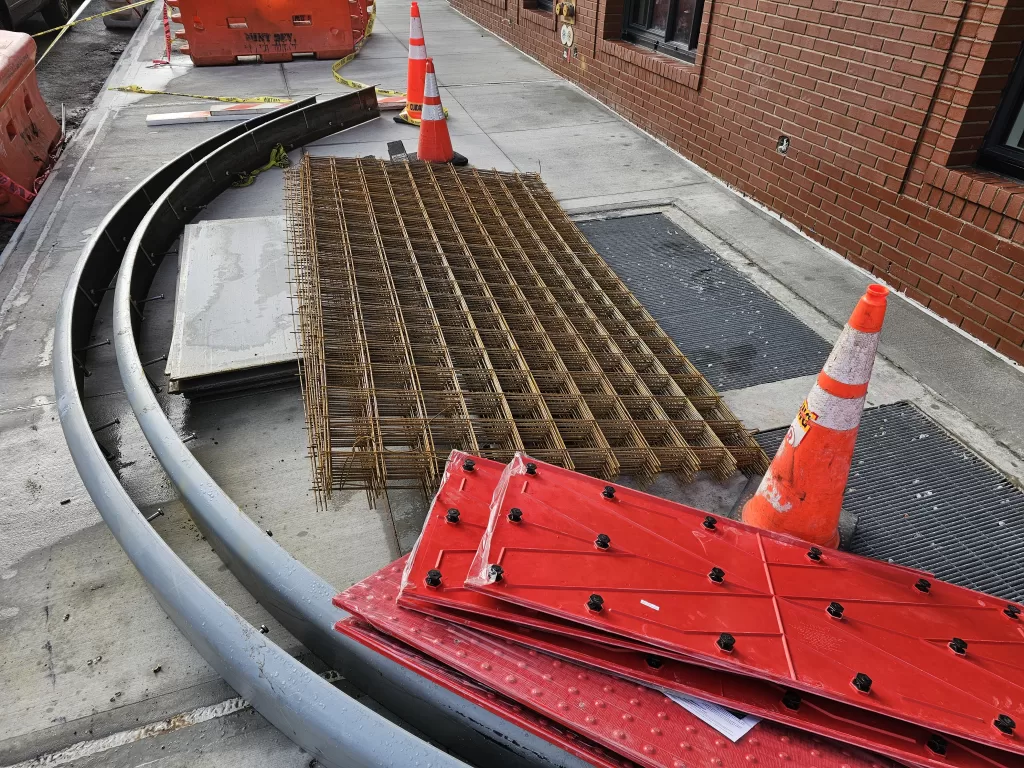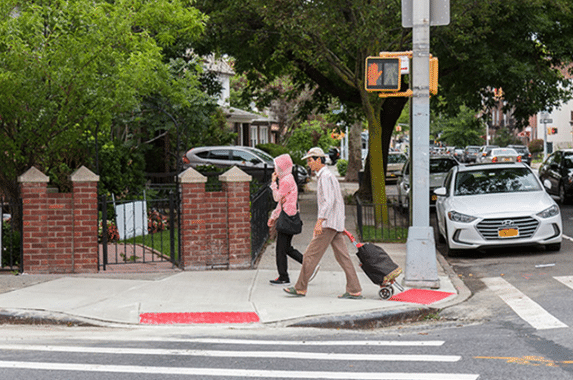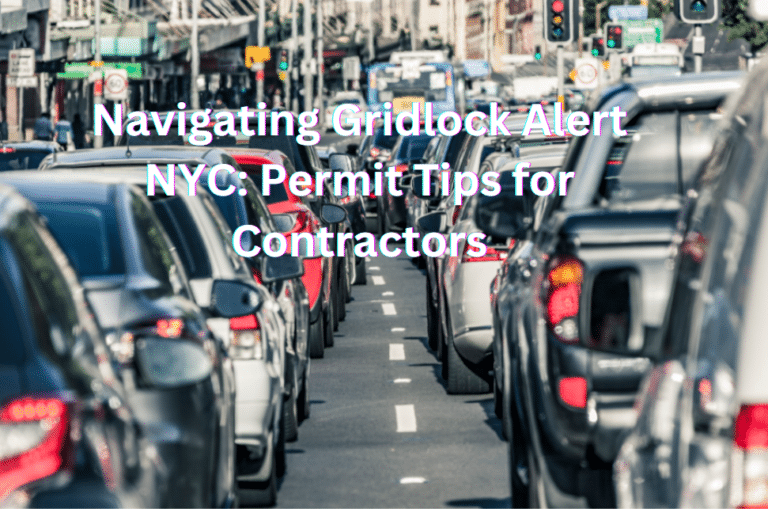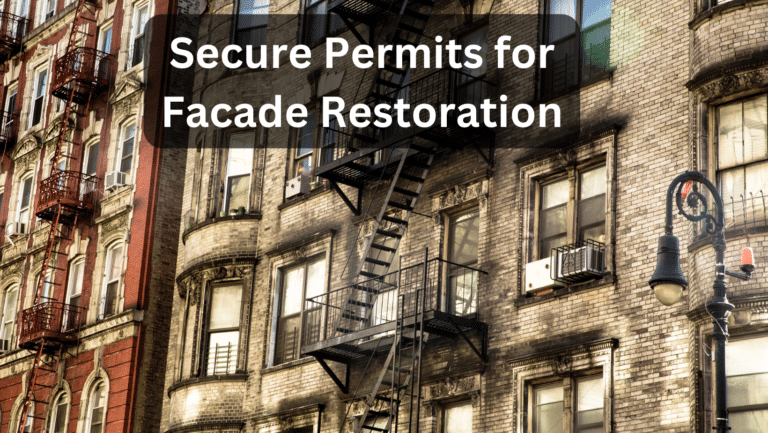Last Updated on January 28, 2025 by Jeffrey Calderon

Pedestrian Ramps: Ensuring Compliance, Safety & Benefits
Pedestrian ramps play a crucial role in creating accessible and inclusive environments for all individuals, regardless of their mobility levels. As we dive into this topic, we’ll explore the origins of pedestrian ramps in Berkeley and how they’ve evolved to have broader implications beyond accessibility.
Understanding compliance with Department of Transportation (DOT) regulations is essential for homeowners and contractors alike. We will discuss slope requirements for flared side curbs and proper installation techniques for detectable warning strips.
Furthermore, identifying potential safety hazards through site inspections and performance evaluations against applicable standards can help ensure that pedestrian ramps are both functional and secure. Additionally, we’ll delve into the economic benefits of equitable infrastructure by examining job creation through investment in accessible infrastructure projects as well as indirect benefits such as seat belt legislation and bike lanes.
Last but not least, when it comes to cases where installing a traditional curb ramp may be impractical or impossible, we will provide guidance on submitting an infeasibility form along with assessing alternative solutions to maintain accessibility within our communities.
The Importance of Pedestrian Ramps for Accessibility
Pedestrian ramps, also known as curb ramps or curb cuts, play an essential role in promoting accessible walkways for individuals with disabilities. They have become a standard feature in urban infrastructure since the 1970s and contribute positively towards various aspects of society such as improved safety legislation and healthier lifestyles.
Origins of Pedestrian Ramps in Berkeley
The concept of pedestrian ramps originated in Berkeley, California, where disability rights activists fought for more accessible public spaces during the 1960s and 70s. This movement led to the installation of the first-ever curb ramp on a sidewalk near UC Berkeley’s campus. The success of this initiative eventually resulted in widespread adoption across cities throughout the United States.
Broader Implications Beyond Accessibility
- Safety: Curb ramps not only provide access to people with mobility impairments but also enhance overall safety by reducing trip hazards for all pedestrians, including those pushing strollers or using wheeled luggage.
- Inclusive Design: By incorporating features like detectable warning surfaces at crosswalks, these designs help visually impaired individuals navigate city streets safely and independently.
- Economic Benefits: Accessible sidewalks encourage increased foot traffic which can boost local businesses’ revenues while fostering vibrant communities that attract new residents and visitors alike.
- Lifestyle Improvements: Walkable neighborhoods promote physical activity among residents leading to healthier lifestyles while reducing reliance on automobiles thus contributing to decreased air pollution levels within urban areas.
To ensure that our cities continue reaping these benefits, it is essential for homeowners and contractors to stay up-to-date with the latest Department of Transportation (DOT) regulations governing pedestrian ramp design, installation, and maintenance. We must ensure that our cities are providing secure, comprehensive settings which take into consideration the requirements of everyone in our society.
Pedestrian ramps are an essential part of any cityscape, providing both accessibility and safety for all users. Compliance with DOT regulations is the key to ensuring that these pedestrian ramps provide a safe environment for everyone.
Pedestrian ramps are essential for promoting accessible walkways, originated from Berkeley in the 1960s and have widespread adoption across cities throughout the United States. They provide safety, inclusive design, economic benefits, and lifestyle improvements while complying with DOT regulations to create safer and more inclusive environments that cater to all members within our communities.
Compliance with DOT Regulations

To maintain compliance with the Department of Transportation (DOT) regulations, homeowners and contractors must be aware of the latest design standards that pertain to curb ramp safety. Proper adherence to these requirements is essential in minimizing slip, trip, and fall incidents on these vital access points.
Slope Requirements for Flared Side Curbs

The angle of a pedestrian ramp is an integral component in terms of its security and practicality. According to ADA Accessibility Guidelines (ADAAG), flared side curbs should have a maximum slope ratio of 1:10 or 1:12 depending on the specific conditions at each location. This means that for every inch of vertical rise, there should be ten or twelve inches of horizontal run respectively. Adhering to this standard ensures that wheelchair users can navigate safely without risking tipping over or losing control.
Proper Installation of Detectable Warning Strips

Detectable warning strips are another critical component in maintaining safe pedestrian ramps. These textured surfaces alert visually impaired pedestrians about upcoming changes in elevation or potential hazards such as street crossings. The Americans with Disabilities Act Standards for Accessible Design (ADASAD) require detectable warning strips to cover at least 24 inches deep along the entire width where pedestrians would encounter them.
To ensure proper installation:
- Select a material that is durable and slip-resistant, such as truncated domes.
- Choose a color that contrasts with the surrounding pavement to enhance visibility for individuals with low vision.
- Ensure the warning strips are securely attached to prevent tripping hazards or detachment over time.
Maintaining compliance with DOT regulations not only promotes accessibility but also helps create safer environments for all pedestrians. By understanding and implementing these design standards, homeowners and contractors can contribute towards building more inclusive communities while minimizing potential safety risks on pedestrian ramps.
It is essential to ensure compliance with DOT regulations in order to guarantee pedestrian safety. Identifying potential safety hazards requires an extensive site inspection and performance evaluation against applicable standards.
Pedestrian ramps are crucial for accessibility, and adherence to DOT regulations is essential in minimizing slip, trip, and fall incidents. Slope requirements of 1:10 or 1:12 must be followed for flared side curbs, while detectable warning strips should be securely attached with durable materials that contrast with the surrounding pavement to enhance visibility.
Identifying Potential Safety Hazards

Ramps are critical to ensuring inclusivity, but they must be carefully designed and installed to avoid potential safety hazards. However, improperly designed or installed ramps can pose safety hazards that may lead to accidents and injuries. To minimize these risks, it is essential to conduct regular site inspections and performance evaluations against applicable standards such as the Department of Transportation (DOT) guidelines.
Site Inspections for Hazard Identification
Robson Forensic, an expert in investigating premises liability cases involving pedestrian ramps, emphasizes the importance of thorough site inspections in identifying potential hazards. These inspections should focus on key aspects like ramp slopes, surface materials, detectable warning strips placement, and overall compliance with DOT regulations.
- Ramp slopes: Ensure that the slope meets DOT requirements for flared side curbs to prevent slips and falls.
- Surface materials: Check if the ramp surfaces are slip-resistant and free from any obstructions or debris that could cause tripping hazards.
- Detectable warning strips: Confirm proper installation according to guidelines so visually impaired pedestrians can safely navigate around them.
- Overall compliance: Assess whether other design elements meet regulatory standards set forth by agencies like DOT.
Performance Evaluations Against Applicable Standards
In addition to site inspections, conducting performance evaluations against relevant standards is crucial in maintaining safe pedestrian environments. This process involves comparing existing ramp designs with established criteria outlined by organizations such as the ADA Standards for Accessible Design and the National Association of City Transportation Officials (NACTO).
By identifying areas where improvements can be made, property owners and contractors can take proactive steps to rectify potential hazards before they lead to accidents. This may involve adjusting ramp slopes, securing warning strips more effectively, or implementing other design changes that promote safety and accessibility.
In conclusion, regular site inspections and performance evaluations are essential in maintaining safe pedestrian environments around ramps. By adhering to DOT guidelines and applicable standards, homeowners and contractors can ensure compliance while minimizing the risk of injuries associated with improperly designed or installed ramps.
Identifying potential risks is essential to guaranteeing the smooth, secure use of pedestrian ramps. By investing in accessible infrastructure, we can create jobs while also achieving indirect benefits such as increased seat belt legislation and bike lanes.
Regular site inspections and performance evaluations are crucial in identifying potential safety hazards associated with pedestrian ramps. By adhering to DOT guidelines and relevant standards, property owners and contractors can take proactive steps to rectify any issues before they lead to accidents or injuries. This may involve adjusting ramp slopes, securing warning strips more effectively, or implementing other design changes that promote safety and accessibility.
Economic Benefits of Equitable Infrastructure
Investing in equitable infrastructure can generate over one million transit-related jobs while improving pay and quality for low-wage workers. This “curb-cut effect” has broader implications that go beyond just improving accessibility; it can contribute positively towards other aspects such as seat belt legislation which has saved countless lives since being introduced, and bike lanes that promote healthier lifestyles while reducing traffic congestion at large.
Job Creation through Investment in Accessible Infrastructure
The development of pedestrian ramps, sidewalks, and other accessible features not only benefits individuals with disabilities but also creates job opportunities within the construction industry. According to a PolicyLink report, investing $1 billion in public transportation infrastructure could create approximately 50,000 new jobs. These investments help boost local economies by providing employment opportunities for contractors, engineers, architects, and laborers who specialize in creating accessible environments.
Indirect Benefits Including Seat Belt Legislation & Bike Lanes
- Seat Belt Legislation: The introduction of seat belt laws is an example of how improvements made for specific groups can benefit society as a whole. In this case, the push for better safety measures led to widespread adoption across all vehicles – saving thousands of lives every year. According to the National Highway Traffic Safety Administration (NHTSA), seat belts have saved nearly 15,000 lives annually since their implementation.
- Bike Lanes: Similarly, bike lanes were initially designed to provide safer spaces for cyclists on busy roads but have had far-reaching effects on overall urban health and well-being. By encouraging more people to cycle, bike lanes help reduce traffic congestion and promote healthier lifestyles. A study published in the International Journal of Environmental Research and Public Health found that cities with more extensive cycling infrastructure had lower rates of obesity, diabetes, and high blood pressure.
In conclusion, investing in accessible infrastructure not only benefits individuals with disabilities but also creates job opportunities and has far-reaching positive effects on society as a whole. The “curb-cut effect” is a prime example of how seemingly small improvements can have significant impacts on the economy, public health, and safety.
Investing in accessible infrastructure is an economically beneficial endeavor that can create jobs and spur other indirect benefits. By understanding when to submit infeasibility forms, as well as assessing alternative solutions for accessibility, we can ensure equitable access to all members of our community.
Investing in equitable infrastructure, such as pedestrian ramps and sidewalks, can create over one million transit-related jobs while improving pay and quality for low-wage workers. This “curb-cut effect” has broader implications that go beyond just improving accessibility; it can contribute positively towards other aspects such as seat belt legislation which has saved countless lives since being introduced, and bike lanes that promote healthier lifestyles while reducing traffic congestion at large.
Infeasibility Forms and Alternative Solutions
There are instances when installing a pedestrian ramp may not be possible due to physical constraints or other factors. In such situations, homeowners and contractors can submit an infeasibility form. This document outlines the reasons why a curb ramp cannot be installed at a specific location, allowing regulatory agencies like DOT to assess whether alternative solutions are necessary for maintaining accessibility. However, it is crucial to remember that these forms should only be used as a last resort after all efforts have been made to accommodate accessibility needs within existing designs.
When to Submit an Infeasibility Form
An infeasibility form should be submitted when:
- The site’s physical constraints prevent the installation of a compliant pedestrian ramp.
- Existing utilities or infrastructure make it impossible or impractical to install a curb ramp.
- The property owner has explored all feasible alternatives but none meet the required standards set by DOT regulations.
If you encounter a situation in which constructing a curb ramp is unfeasible or impractical due to existing utilities/infrastructure, consult with your local DOT office for guidance on submitting an infeasibility form. You can also review their guidelines on how best to complete this documentation by visiting their official website: NYC Department of Transportation – Sidewalk Program.
Assessing Alternative Solutions for Accessibility
In cases where traditional pedestrian ramps cannot be installed, there might still exist viable alternative solutions that maintain compliance with accessibility requirements. Some examples include:
- Raised crosswalks: These create level crossings between sidewalks and streets while slowing down vehicular traffic, making it safer for pedestrians with disabilities.
- Accessible pedestrian signals (APS): APS devices provide audible and tactile cues to help visually impaired individuals safely navigate intersections.
- Sidewalk extensions: Also known as “bulb-outs,” these extend the sidewalk into the parking lane, reducing crossing distances and improving visibility between pedestrians and drivers.
For the most suitable solution for your particular situation, seek advice from a competent expert such as an accessibility specialist or civil engineer. They can assess site conditions and recommend appropriate measures that comply with DOT regulations while ensuring safe access for all users. For more information on accessible design solutions, visit the U.S. Access Board’s ADA Standards page.
Homeowners and contractors can submit an infeasibility form when physical constraints or other factors prevent the installation of a pedestrian ramp. However, this should only be used as a last resort after all efforts have been made to accommodate accessibility needs within existing designs. Alternative solutions such as raised crosswalks, accessible pedestrian signals, and sidewalk extensions may also maintain compliance with accessibility requirements.
FAQs in Relation to Pedestrian Ramps
What is a Pedestrian Ramp?
A pedestrian ramp, also known as a curb ramp or wheelchair ramp, is an inclined surface that connects the sidewalk to the street level. It provides smooth and safe access for people with disabilities, strollers, bicycles, and other wheeled devices. Pedestrian ramps are essential components of accessible urban infrastructure.
Why are Ramps Important for Disabled People?
Ramps are crucial for disabled individuals because they facilitate mobility and independence by providing barrier-free access to public spaces. They enable wheelchair users and those with limited mobility to navigate sidewalks and cross streets safely without encountering obstacles like curbs or steps.
What is the Purpose of Ramps?
The primary purpose of ramps is to create accessible environments by removing physical barriers in public spaces. Ramps ensure compliance with accessibility laws such as the Americans with Disabilities Act (ADA), which mandates equal access for all individuals regardless of their abilities.
Why and Where Are Ramps Required?
Ramps are required at intersections, parking lots, entrances to buildings, transit stops, schools, accessible parking spaces, and other areas where changes in elevation occur between walkways and road surfaces. These installations ensure compliance with ADA guidelines while promoting inclusive design principles in urban planning.
Conclusion
Overall, pedestrian ramps are a crucial component of accessible infrastructure that benefit not only those with disabilities but also the broader community.
Compliance with DOT regulations and identifying potential safety hazards are essential for ensuring their effectiveness while investing in equitable infrastructure can have economic benefits such as job creation.
When faced with infeasibility, alternative solutions should be assessed to maintain accessibility.
If you need assistance obtaining DOT permits or navigating the process of installing pedestrian ramps, Permits In No Time is here to help.






